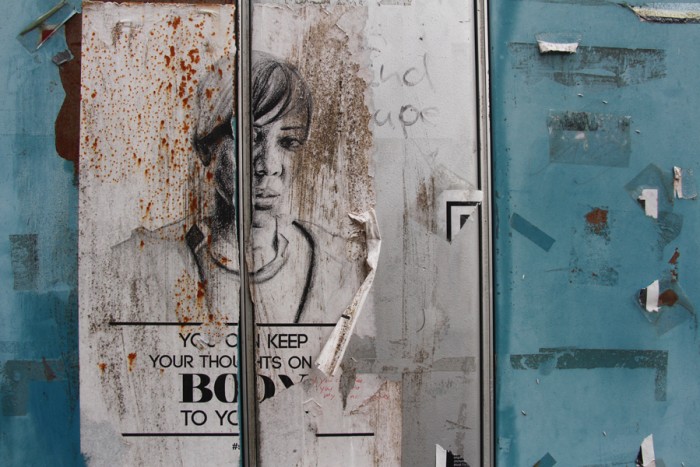
Back in 2012, Tatyana Fazlalizadeh finally got fed up with being harassed by men when she walked down the streets in her neighborhood.
In response, the Brooklyn-based painter and illustrator began pasting a series of stark posters on walls in the area, featuring portraits of women with phrases meant provoke harassers to question their intentions.
With captions like “my outfit is not an invitation” and “I am not public space,” Fazlalizadeh hoped the so-called “Stop Telling Women to Smile” campaign would create dialogue in spaces, “where [women] are so often made to feel uncomfortable and unsafe.”
Now she’s taking her campaign international. First stop — Mexico City.
https://twitter.com/_melllissa/status/519570196885827584
Fazlalizadeh headed there last September to record how the issue was impacting Mexican women.
She was joined by Fusion, a millennial-oriented multi-platform media company started by Disney and Univision, which helped produce a series of videos featuring women’s stories and quotes from their harassers.
The resulting interactive website features the faces and voices of 76 individuals, including men and older women like Carmen Ruiz, 63, who reports hearing comments like, “look, the old lady is very hot and has great jugs!”
Volunteers with Stop Telling Women to Smile (aka #STWTS) targeted specific areas plagued by harassment to hang the posters. Mexico has some of the highest rates of sexual violence globally, with nearly 44 percent of women experiencing it in their lifetime.
Artists, photographers, and community members are encouraged to participate in the project by finding wall space, organizing group discussions, and becoming wheat-pasting volunteers.
Plastered around streets, college campuses, and on the back of phone booths across the U.S. and now in Mexico, Fazlalizadeh’s posters spark conversation about harassment in public, but also in spaces like schools and universities where women ought to feel safe.
Last April posters began appearing around the UW campus and elsewhere in Seattle.
While Fazlalizadeh’s campaign crossed international borders for the first time just a few months ago, it isn’t the first to global effort to combat street harassment.
In Egypt, a project called HarassMap is fighting a toxic environment of sexual harassment by creating an online system to report incidents. Reports are complied into a map displaying the number of incidents in a particular area, in the hopes of drawing attention to neighborhoods overrun by cat calls, until harassment is no longer socially acceptable.
My own experience walking on Seattle sidewalks may not be as nauseating as the harassment and violence faced in Mexico or Egypt. But like most women, fear of harassment still dictates where I decide to walk when I’m alone.
The cliche of a street harassment — men standing on a street, shouting at women as they pass by — doesn’t always give the full picture.
On a recent walk to the Dollar Tree on the Ave, I was trailed by a man on a skateboard.
I was late, a few minutes past closing. In my perseverance to search for batteries and a late-night snack, I turned around to walk toward the District Market.
His initial, “hi” and “hey” stuck out from the crowd. He started to glide past me, hovering off to my left with his arms out, saying, “why won’t you talk to me?”
I jaywalked, and I thought it was over as he skateboarded away without my response. But moments later, I heard his wheels clatter against the pavement. I tensed up, peering down the street to see how far away I was from the market. I could see the sign.
Should I run?
Nothing happened. He rolled away down the street, out of sight. I worried he would be at the end of the road waiting, but I was lucky. He was gone.
At the market I waited in line to buy batteries, and then decided to take the long way home.
Calling the police seemed pointless now that he was nowhere to be seen.
It’s hard to say what would have happened if I had actually called. Survivors of gender-based violence and harassment are often let down by the criminal justice system. They can be re-victimized by police officers and the judicial process by being victim-blamed.
A few months ago when Julia Marquand was groped near Westlake Park, she confronted the man, snapped a photo, and headed the Seattle Police Department’s West Precinct. The picture was her evidence.
It didn’t seem to help.
Her short-lived conversation with an officer left the impression that nothing would be done. Disappointed and determined to find justice, she took to Twitter to call out her perpetrator.
A few hours later after being contacted by various news agencies, SPD assigned a detective to re-evaluate her case.
https://twitter.com/JuliaMarquand/status/521720588990025728/
Standing up to harassment and violence against women can feel daunting for individual victims, says Sarah MacDonald, communications director at Legal Voice, an outlet in Seattle that works secure, develop, and maintain rights for women.
“There was a woman who was a survivor of domestic violence, but she needed to take time off work to address the issue of domestic violence in her family, and get her and her family safe,” MacDonald recalls. “Shortly after returning to work, she was fired. We got involved and said, ‘Thats not right.’”
Seeing Fazlalizadeh’s posters plastered on Seattle’s walls has me hopeful that justice can be served in places other than a police station.

